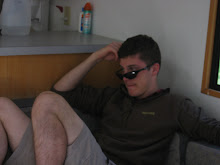I know that the title of this post is cheesy. But hey, let's not mince words; I'm a cheesy person! Besides, it describes the pictures really well. The past two weeks, our group visited the Andrei Rublev Icon Museum, which is housed in the ancient St. Andronik Monastery. We also visited the Novodevichy Convent (New Maiden Convent) and its accompanying cemetery. Below, I begin with pictures of the St. Andronik Monastery, which suffered a lot of damage after the October Revolution.
 This is the very plain grave of the famous writer, Mikhail Bulgakov, which you can find in the cemetery next to the Novodevichy Convent. Last winter I acted in his play, Zoya's Apartment.
This is the very plain grave of the famous writer, Mikhail Bulgakov, which you can find in the cemetery next to the Novodevichy Convent. Last winter I acted in his play, Zoya's Apartment. This is Boris Yeltsin's grave. Also very plain...
This is Boris Yeltsin's grave. Also very plain... ...at least, compared to SOME people's graves. Graves like Khruschev's are a lot nicer.
...at least, compared to SOME people's graves. Graves like Khruschev's are a lot nicer. This is the church in the Novodevichy convent. The Novodevichy convent is notable for a few reasons; it is were Peter the Great sent his first wife (when he wanted a new one) and his older sister (when she led a rebellion against him), it is a fortress (I guess they were martial nuns or something?), and it was one of the richest of the church's holdings. When Peter sent his sister to the convent, he had the traitors hung in front of her house and didn't have them removed for a while, so she could think about what she did whenever she smelled them.
This is the church in the Novodevichy convent. The Novodevichy convent is notable for a few reasons; it is were Peter the Great sent his first wife (when he wanted a new one) and his older sister (when she led a rebellion against him), it is a fortress (I guess they were martial nuns or something?), and it was one of the richest of the church's holdings. When Peter sent his sister to the convent, he had the traitors hung in front of her house and didn't have them removed for a while, so she could think about what she did whenever she smelled them. And in the strangest of coincidences, in a city of 15 million people, I bumped into my friend Susan from Alaska at the convent.
And in the strangest of coincidences, in a city of 15 million people, I bumped into my friend Susan from Alaska at the convent.I hope you all enjoyed Thanksgiving. We threw a small Thanksgiving celebration at the dorms here in Moscow that morphed into a raucous drinking party, or so I heard. It happened after I left. I promise.
(Actually, I'm serious, Mom. I really did leave at 9pm because I was dead-tired.)
(Actually, I'm serious, Mom. I really did leave at 9pm because I was dead-tired.)
































